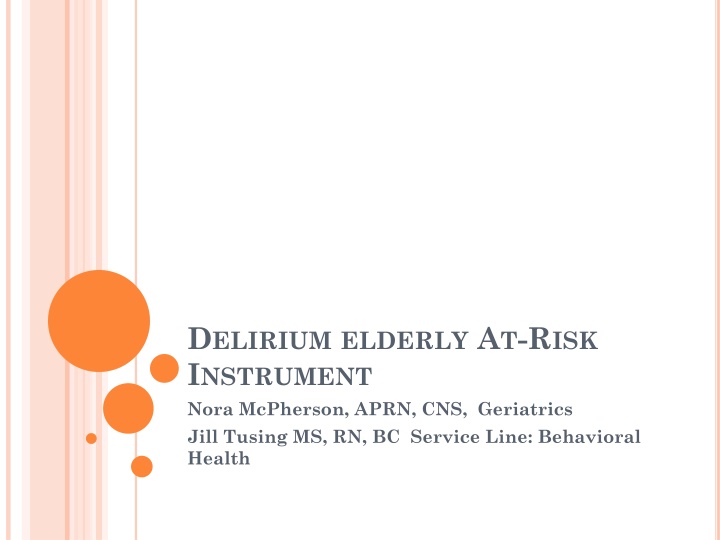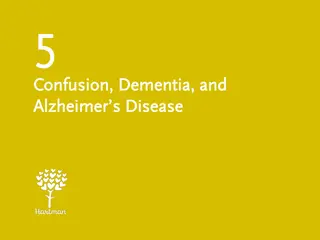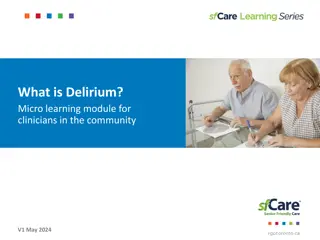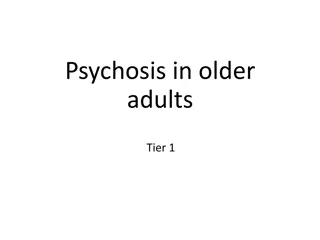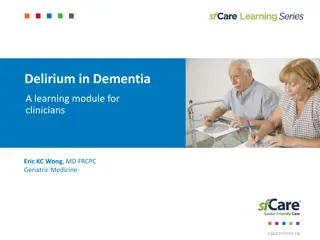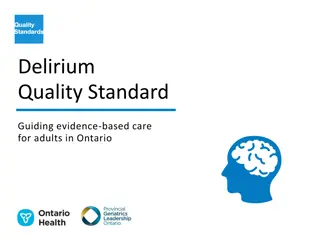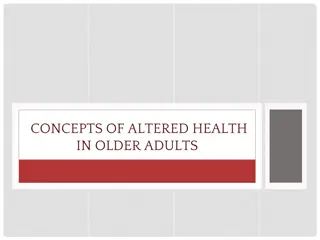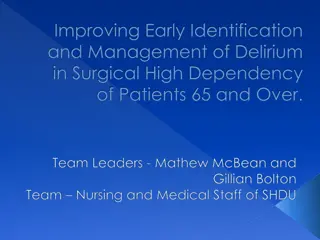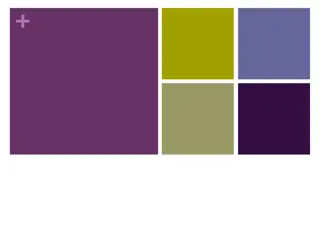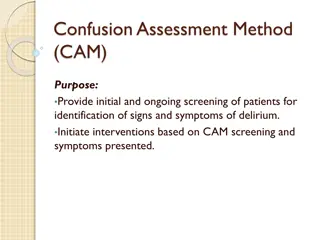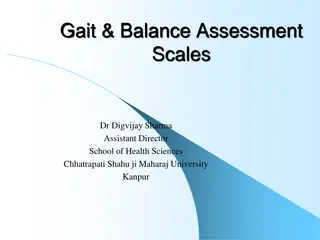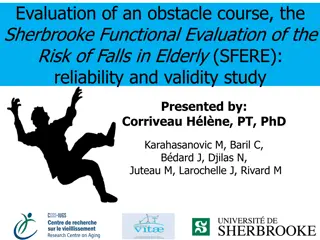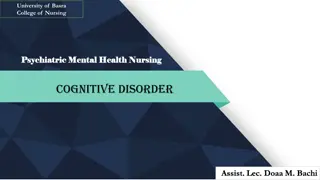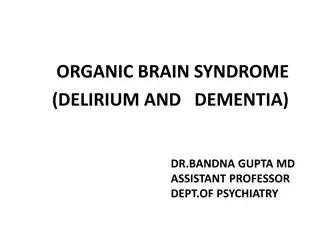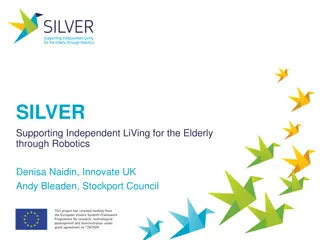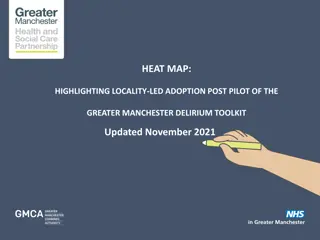Delirium Risk Assessment Tool for Elderly Patients
Assessing the risk of post-operative delirium in elderly patients is crucial for improving outcomes and reducing complications. The Delirium Elderly At-Risk (DEAR) instrument is a valuable tool that evaluates multiple domains including age, sensory impairment, functional dependence, substance use, and cognition to identify high-risk patients. By utilizing this instrument and following scoring guidelines, healthcare professionals can proactively assess and mitigate the risk of delirium in elderly individuals undergoing elective procedures, ultimately enhancing patient care and outcomes.
Download Presentation

Please find below an Image/Link to download the presentation.
The content on the website is provided AS IS for your information and personal use only. It may not be sold, licensed, or shared on other websites without obtaining consent from the author.If you encounter any issues during the download, it is possible that the publisher has removed the file from their server.
You are allowed to download the files provided on this website for personal or commercial use, subject to the condition that they are used lawfully. All files are the property of their respective owners.
The content on the website is provided AS IS for your information and personal use only. It may not be sold, licensed, or shared on other websites without obtaining consent from the author.
E N D
Presentation Transcript
DELIRIUM ELDERLY AT-RISK INSTRUMENT Nora McPherson, APRN, CNS, Geriatrics Jill Tusing MS, RN, BC Service Line: Behavioral Health
SBAR: DELIRIUM IDENTIFYING HIGH RISK PATIENTS Situation: Delirium (acute confusion) a common, under recognized, post-operative complication in elective orthopaedic patients (10%-40%); manifests as acute impairment in cognition and attention. Background: Post-operative delirium is associated with poor outcomes, greater costs, longer lengths of stays, poor recovery, institutionalization, and mortality.
Assessment: Recommendation: Trial delirium risk assessment tool (DEAR) with elective total joint population age 65 and older to identify high risk for delirium. Phase 2 (future plans): On care units, patient screening every shift with use of Confusion Assessment Method (CAM) Currently, HE does not have process to screen patient pre-op for risk Screening pts. may allow for early interventions to reduce severity
Delirium Elderly At-Risk (DEAR) instrument is used to assess risk for developing post-operative delirium. 5 scoring domains are listed below: Yes No Patient age Age > 80 Sensory Impairment Patient uses hearing aid and/or has very low vision Functional Dependence Patient requires assistance with any of the following: Bathing, dressing toileting, grooming, or feeding Substance Use Patient consumes >3 drinks of alcohol per week and/or Patient takes benzodiazepine >3 times/week Cognition Previous post-op delirium/confusion or Failed Clock-drawing Score A DEAR score of Yes > 1 places the patient at higher risk of developing post operative delirium.
DEAR INSTRUMENT INSTRUCTIONS The circle is a clock face. Ask your patient to place numbers and hands (small and large) on the face so the time reads 10 minutes after three o clock. The instructions: May be repeated as often as requested No other directions or assistance should be given Do not cover up or conceal any time pieces in the room After your patient has completed this task, you may score their efforts as pass or fail. Please review the following examples displaying pass and fail clocks.
SCORING GUIDELINES : PASSOR FAIL PASS: Hands and numbers are all present in correct positions. Patient corrects without prompting are acceptable. There are slight errors in placement of hands OR One missing number without number spacing errors. Moderate errors in placement of hands, confusion with small and large hands OR Number spacing errors alone.
Scoring Passed Guidelines: Placement of hands is significantly off course OR Number spacing is inappropriate. Example: Even though there is bunching, distortion not grossly inappropriate. Typically seen in those who are cued to spatial mistakes once they get to the 6 (because they know it is supposed to be at the bottom), and make correction only to commit same error in subsequent numbers.
Score Fail Guidelines: Clock hands are used inappropriately OR There is use of a digital display Circling of numbers OR Perseveration in writing of numbers Example: The clock hands are clearly pointing inward. This is scored 6, even though the 2 and 3 are correctly indicated, because there is clear evidence that problem solving how to correctly draw in the hands is lacking.
Score Fail Example: Here is perseveration of numbers (3's and 8's). Only one example of perseverated numbers is needed for a score of 6. The hands are not included in this sample to focus on illustrating number perseveration.
Score Fail Example: A digital representation of 3:10 is drawn. This is often drawn in the middle of the clock face, or even well outside of it.
Score Fail Example: The numbers are circled to indicate 3:10.
Score Fail Example: This is an inappropriate use of clock hands, where a straight line is drawn from the 3 to the 2, without use of the center of the clock.
Score Fail Guidelines: Numbers are crowded to one end of the clock. Reversed in order or absent. Example: Numbers are reversed.
Score Fail Example: All of the numbers are crowded into to one end of the clock face.
Score Fail Guidelines: There is significant distortion in number sequences. Counterclockwise order many missing numbers OR Number placed outside of clock face border. Example: There are many added numbers. This tends to occur when the patient loses track of the task at hand (drawing the numbers for the clock) and continues to add numbers until they run out of space.
Score Fail Example: Some numbers fall outside of the border
Score Fail Example: Numbers placed outside of the clock face. Even if all other criteria are met.
Score Fail Example: Prompting needed. This is a fairly common presentation of "drawing in the numbers". When this is seen, prompt the patient to put in numbers instead of dashes, allowing them to erase. This should not be scored unless the patient is unable to place the numbers at all, or is significantly confused by the directions.
Score Fail Only vague representation of a clock or irrelevant spatial representation exist. Numbers and clock face are no longer connected in the drawing.
Score Fail Result cannot be interpreted OR No attempt is made to draw a clock
DEAR scores >1 indicate patient is at higher risk for developing delirium. : Yes X X No Patient age Age > 80 Sensory Impairment Patient uses hearing aid and/or has very low vision Functional Dependence Patient requires assistance with any of the following: Bathing, dressing toileting, grooming, or feeding X Substance Use Patient consumes >3 drinks of alcohol per week and/or Patient takes benzodiazepine >3 times/week X Cognition Previous post-op delirium/confusion or Failed Clock-drawing Score X A DEAR score of Yes > 1 places the patient at higher risk of developing post operative delirium. 2
Scoring DEAR Tool Add up all of the yes scores on the left side of the tool and place score on bottom. Scores of over 1 are considered high risk. If a patient is scored to be at high risk for delirium, communicate this risk with the medical team. Place High risk for delirium sticker on patient Care Plan (or write it yourself).
REFERENCES Feter, S., Dunbar, M., MacLeod, H., Morrison, M., MacKnight, C., et al. (2005) Predicting post- operative delirium in elective orthopaedic patients: the Delirium Elderly At-Risk (DEAR) instrument. Age and Ageing, 34(2), 169-184. HealthEast A3 team: Joe Clubb, Director Behavior Health, Dr. David Frenz; Dr. Alvin Holm, Jill Tusing RN Education, Nora McPherson, APRN, CNS.
